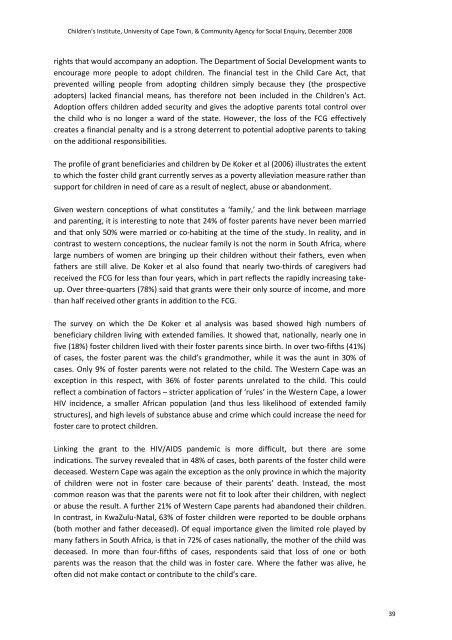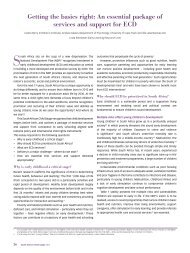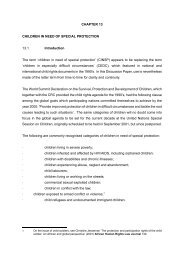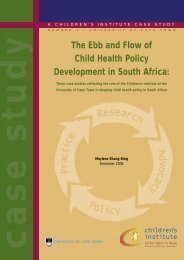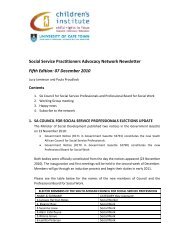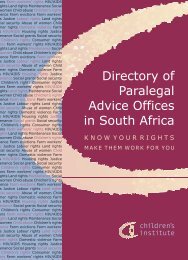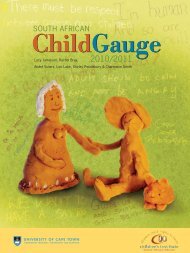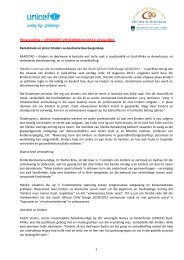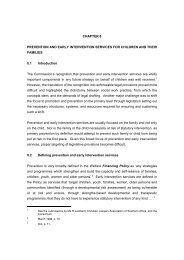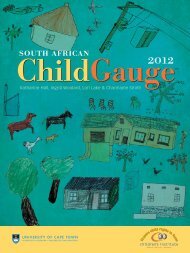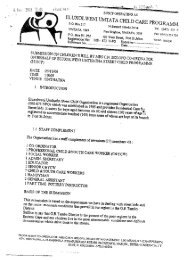Developing social policy for children in the context of HIV/AIDS:
Developing social policy for children in the context of HIV/AIDS:
Developing social policy for children in the context of HIV/AIDS:
You also want an ePaper? Increase the reach of your titles
YUMPU automatically turns print PDFs into web optimized ePapers that Google loves.
Children’s Institute, University <strong>of</strong> Cape Town, & Community Agency <strong>for</strong> Social Enquiry, December 2008<br />
rights that would accompany an adoption. The Department <strong>of</strong> Social Development wants to<br />
encourage more people to adopt <strong>children</strong>. The f<strong>in</strong>ancial test <strong>in</strong> <strong>the</strong> Child Care Act, that<br />
prevented will<strong>in</strong>g people from adopt<strong>in</strong>g <strong>children</strong> simply because <strong>the</strong>y (<strong>the</strong> prospective<br />
adopters) lacked f<strong>in</strong>ancial means, has <strong>the</strong>re<strong>for</strong>e not been <strong>in</strong>cluded <strong>in</strong> <strong>the</strong> Children's Act.<br />
Adoption <strong>of</strong>fers <strong>children</strong> added security and gives <strong>the</strong> adoptive parents total control over<br />
<strong>the</strong> child who is no longer a ward <strong>of</strong> <strong>the</strong> state. However, <strong>the</strong> loss <strong>of</strong> <strong>the</strong> FCG effectively<br />
creates a f<strong>in</strong>ancial penalty and is a strong deterrent to potential adoptive parents to tak<strong>in</strong>g<br />
on <strong>the</strong> additional responsibilities.<br />
The pr<strong>of</strong>ile <strong>of</strong> grant beneficiaries and <strong>children</strong> by De Koker et al (2006) illustrates <strong>the</strong> extent<br />
to which <strong>the</strong> foster child grant currently serves as a poverty alleviation measure ra<strong>the</strong>r than<br />
support <strong>for</strong> <strong>children</strong> <strong>in</strong> need <strong>of</strong> care as a result <strong>of</strong> neglect, abuse or abandonment.<br />
Given western conceptions <strong>of</strong> what constitutes a ‘family,’ and <strong>the</strong> l<strong>in</strong>k between marriage<br />
and parent<strong>in</strong>g, it is <strong>in</strong>terest<strong>in</strong>g to note that 24% <strong>of</strong> foster parents have never been married<br />
and that only 50% were married or co‐habit<strong>in</strong>g at <strong>the</strong> time <strong>of</strong> <strong>the</strong> study. In reality, and <strong>in</strong><br />
contrast to western conceptions, <strong>the</strong> nuclear family is not <strong>the</strong> norm <strong>in</strong> South Africa, where<br />
large numbers <strong>of</strong> women are br<strong>in</strong>g<strong>in</strong>g up <strong>the</strong>ir <strong>children</strong> without <strong>the</strong>ir fa<strong>the</strong>rs, even when<br />
fa<strong>the</strong>rs are still alive. De Koker et al also found that nearly two‐thirds <strong>of</strong> caregivers had<br />
received <strong>the</strong> FCG <strong>for</strong> less than four years, which <strong>in</strong> part reflects <strong>the</strong> rapidly <strong>in</strong>creas<strong>in</strong>g takeup.<br />
Over three‐quarters (78%) said that grants were <strong>the</strong>ir only source <strong>of</strong> <strong>in</strong>come, and more<br />
than half received o<strong>the</strong>r grants <strong>in</strong> addition to <strong>the</strong> FCG.<br />
The survey on which <strong>the</strong> De Koker et al analysis was based showed high numbers <strong>of</strong><br />
beneficiary <strong>children</strong> liv<strong>in</strong>g with extended families. It showed that, nationally, nearly one <strong>in</strong><br />
five (18%) foster <strong>children</strong> lived with <strong>the</strong>ir foster parents s<strong>in</strong>ce birth. In over two‐fifths (41%)<br />
<strong>of</strong> cases, <strong>the</strong> foster parent was <strong>the</strong> child’s grandmo<strong>the</strong>r, while it was <strong>the</strong> aunt <strong>in</strong> 30% <strong>of</strong><br />
cases. Only 9% <strong>of</strong> foster parents were not related to <strong>the</strong> child. The Western Cape was an<br />
exception <strong>in</strong> this respect, with 36% <strong>of</strong> foster parents unrelated to <strong>the</strong> child. This could<br />
reflect a comb<strong>in</strong>ation <strong>of</strong> factors – stricter application <strong>of</strong> ‘rules’ <strong>in</strong> <strong>the</strong> Western Cape, a lower<br />
<strong>HIV</strong> <strong>in</strong>cidence, a smaller African population (and thus less likelihood <strong>of</strong> extended family<br />
structures), and high levels <strong>of</strong> substance abuse and crime which could <strong>in</strong>crease <strong>the</strong> need <strong>for</strong><br />
foster care to protect <strong>children</strong>.<br />
L<strong>in</strong>k<strong>in</strong>g <strong>the</strong> grant to <strong>the</strong> <strong>HIV</strong>/<strong>AIDS</strong> pandemic is more difficult, but <strong>the</strong>re are some<br />
<strong>in</strong>dications. The survey revealed that <strong>in</strong> 48% <strong>of</strong> cases, both parents <strong>of</strong> <strong>the</strong> foster child were<br />
deceased. Western Cape was aga<strong>in</strong> <strong>the</strong> exception as <strong>the</strong> only prov<strong>in</strong>ce <strong>in</strong> which <strong>the</strong> majority<br />
<strong>of</strong> <strong>children</strong> were not <strong>in</strong> foster care because <strong>of</strong> <strong>the</strong>ir parents’ death. Instead, <strong>the</strong> most<br />
common reason was that <strong>the</strong> parents were not fit to look after <strong>the</strong>ir <strong>children</strong>, with neglect<br />
or abuse <strong>the</strong> result. A fur<strong>the</strong>r 21% <strong>of</strong> Western Cape parents had abandoned <strong>the</strong>ir <strong>children</strong>.<br />
In contrast, <strong>in</strong> KwaZulu‐Natal, 63% <strong>of</strong> foster <strong>children</strong> were reported to be double orphans<br />
(both mo<strong>the</strong>r and fa<strong>the</strong>r deceased). Of equal importance given <strong>the</strong> limited role played by<br />
many fa<strong>the</strong>rs <strong>in</strong> South Africa, is that <strong>in</strong> 72% <strong>of</strong> cases nationally, <strong>the</strong> mo<strong>the</strong>r <strong>of</strong> <strong>the</strong> child was<br />
deceased. In more than four‐fifths <strong>of</strong> cases, respondents said that loss <strong>of</strong> one or both<br />
parents was <strong>the</strong> reason that <strong>the</strong> child was <strong>in</strong> foster care. Where <strong>the</strong> fa<strong>the</strong>r was alive, he<br />
<strong>of</strong>ten did not make contact or contribute to <strong>the</strong> child’s care.<br />
39


